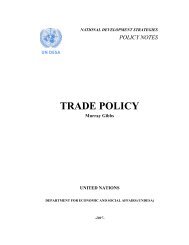Guidelines on the Safe Use of Urine and Faeces in ... - EcoSanRes
Guidelines on the Safe Use of Urine and Faeces in ... - EcoSanRes
Guidelines on the Safe Use of Urine and Faeces in ... - EcoSanRes
Create successful ePaper yourself
Turn your PDF publications into a flip-book with our unique Google optimized e-Paper software.
Carol<strong>in</strong>e Schönn<strong>in</strong>g <strong>and</strong> Thor Axel Stenström<br />
a withhold<strong>in</strong>g time <strong>of</strong> a few weeks corresp<strong>on</strong>ded to <strong>the</strong> suggested storage time <strong>of</strong> <strong>on</strong>e m<strong>on</strong>th<br />
at 20°C (Höglund et al., 2002). The <strong>on</strong>ly difference with not requir<strong>in</strong>g storage systems would<br />
thus be exposure to potentially higher c<strong>on</strong>centrati<strong>on</strong>s <strong>of</strong> pathogens when apply<strong>in</strong>g ur<strong>in</strong>e <strong>and</strong><br />
enter<strong>in</strong>g or work<strong>in</strong>g <strong>in</strong> <strong>the</strong> fields.<br />
Table 6. Recommended Swedish guidel<strong>in</strong>e storage times for ur<strong>in</strong>e mixture a based <strong>on</strong> estimated<br />
pathogen c<strong>on</strong>tent b <strong>and</strong> recommended crop for larger systems c . (Adapted from Jönss<strong>on</strong> et al., 2000<br />
<strong>and</strong> Höglund, 2001)<br />
Storage<br />
temperature<br />
Storage time<br />
Possible<br />
pathogens <strong>in</strong> <strong>the</strong><br />
ur<strong>in</strong>e mixture after<br />
storage<br />
Recommended crops<br />
4°C ≥1 m<strong>on</strong>th Viruses, protozoa Food <strong>and</strong> fodder crops that are to be<br />
processed<br />
4°C ≥6 m<strong>on</strong>ths Viruses Food crops that are to be processed,<br />
fodder crops d<br />
20°C ≥1 m<strong>on</strong>th Viruses Food crops that are to be processed,<br />
fodder crops d<br />
20°C ≥6 m<strong>on</strong>ths Probably n<strong>on</strong>e All crops e<br />
a<br />
<strong>Ur<strong>in</strong>e</strong> or ur<strong>in</strong>e <strong>and</strong> water. When diluted it is assumed that <strong>the</strong> ur<strong>in</strong>e mixture has at least pH 8.8 <strong>and</strong> a nitrogen<br />
c<strong>on</strong>centrati<strong>on</strong> <strong>of</strong> at least 1 g/l.<br />
b<br />
Gram-positive bacteria <strong>and</strong> spore-form<strong>in</strong>g bacteria are not <strong>in</strong>cluded <strong>in</strong> <strong>the</strong> underly<strong>in</strong>g risk assessments, but are not<br />
normally recognized for caus<strong>in</strong>g any <strong>of</strong> <strong>the</strong> <strong>in</strong>fecti<strong>on</strong>s <strong>of</strong> c<strong>on</strong>cern.<br />
c<br />
A larger system <strong>in</strong> this case is a system where <strong>the</strong> ur<strong>in</strong>e mixture is used to fertilize crops that will be c<strong>on</strong>sumed by<br />
<strong>in</strong>dividuals o<strong>the</strong>r than members <strong>of</strong> <strong>the</strong> household from which <strong>the</strong> ur<strong>in</strong>e was collected.<br />
d<br />
Not grassl<strong>and</strong>s for producti<strong>on</strong> <strong>of</strong> fodder.<br />
e<br />
For food crops that are c<strong>on</strong>sumed raw it is recommended that <strong>the</strong> ur<strong>in</strong>e be applied at least <strong>on</strong>e m<strong>on</strong>th before<br />
harvest<strong>in</strong>g <strong>and</strong> that it be <strong>in</strong>corporated <strong>in</strong>to <strong>the</strong> ground if <strong>the</strong> edible parts grow above <strong>the</strong> soil surface.<br />
Dur<strong>in</strong>g storage <strong>the</strong> ur<strong>in</strong>e should be c<strong>on</strong>ta<strong>in</strong>ed <strong>in</strong> a sealed tank or c<strong>on</strong>ta<strong>in</strong>er. This prevents<br />
humans <strong>and</strong> animals com<strong>in</strong>g <strong>in</strong>to c<strong>on</strong>tact with <strong>the</strong> ur<strong>in</strong>e <strong>and</strong> h<strong>in</strong>ders evaporati<strong>on</strong> <strong>of</strong> amm<strong>on</strong>ia,<br />
thus decreas<strong>in</strong>g <strong>the</strong> risk <strong>of</strong> odour <strong>and</strong> loss <strong>of</strong> plant-available nitrogen.<br />
The ur<strong>in</strong>e should preferably not be diluted. C<strong>on</strong>centrated ur<strong>in</strong>e provides a harsher<br />
envir<strong>on</strong>ment for microorganisms, <strong>in</strong>creases <strong>the</strong> die-<strong>of</strong>f rate <strong>of</strong> pathogens <strong>and</strong> prevents breed<strong>in</strong>g<br />
<strong>of</strong> mosquitoes. Thus, <strong>the</strong> less water that dilutes <strong>the</strong> ur<strong>in</strong>e <strong>the</strong> better.<br />
O<strong>the</strong>r possible treatments<br />
So far, storage at ambient temperature is <strong>the</strong> <strong>on</strong>ly method practised to sanitize ur<strong>in</strong>e. Methods<br />
to c<strong>on</strong>centrate <strong>the</strong> nutrients <strong>in</strong> ur<strong>in</strong>e have been tested but are not yet efficient enough,<br />
commercially available or evaluated from a hygienic po<strong>in</strong>t <strong>of</strong> view. Some, e.g. evaporati<strong>on</strong><br />
<strong>of</strong> nitrogen (amm<strong>on</strong>ia) through heat applicati<strong>on</strong> will substantially reduce <strong>the</strong> number <strong>of</strong><br />
microorganisms.<br />
Dry<strong>in</strong>g ur<strong>in</strong>e <strong>in</strong> open trenches has been tested <strong>in</strong> Sweden <strong>and</strong> Mali but will result <strong>in</strong> substantial<br />
loss <strong>of</strong> nitrogen, while phosphorous <strong>and</strong> potassium will be reta<strong>in</strong>ed. A dry ur<strong>in</strong>e fracti<strong>on</strong> (<strong>in</strong> <strong>the</strong><br />
form <strong>of</strong> a powder) has not been shown to pose microbial health risks.<br />
Increased temperature or pH <strong>of</strong> <strong>the</strong> collected ur<strong>in</strong>e would fur<strong>the</strong>r speed up <strong>the</strong> <strong>in</strong>activati<strong>on</strong><br />
<strong>of</strong> potential pathogens. The relative <strong>in</strong>creased <strong>in</strong>activati<strong>on</strong> rates at temperatures above 20°C<br />
have not been tested <strong>and</strong> need to be quantified.<br />
16

















